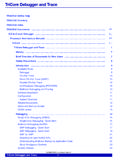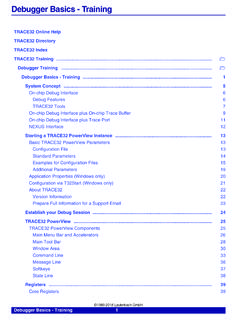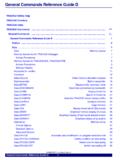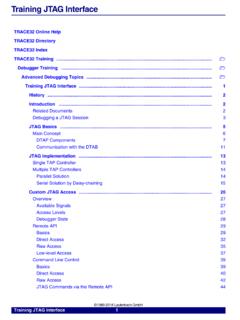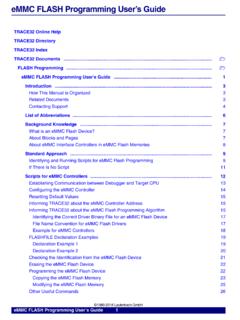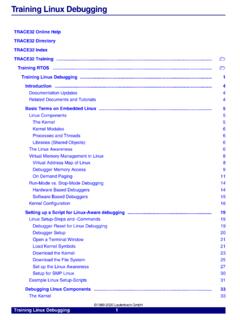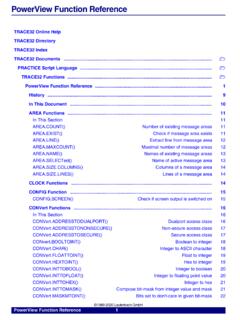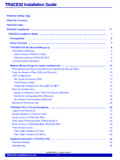Transcription of Application Note Debug Cable TriCore - Lauterbach
1 Application Note Debug Cable TriCore 1 1989-2020 Lauterbach GmbHApplication Note Debug Cable TriCoreTRACE32 Online Help TRACE32 Directory TRACE32 Index TRACE32 Documents .. ICD In-Circuit debugger .. Processor Architecture Manuals .. TriCore .. TriCore Application notes .. Application Note Debug Cable TriCore ..1 Introduction ..4 Debug Protocols ..5 JTAG5 Multi-Chip Debugging (Daisy-Chaining Multiple TAP Controllers)5 Enabling JTAG on TriCore Devices6 DAP6 DAP Over Dedicated Pins6 DAP over CAN7 Connector Standards and Signals ..8 Description of Signals8 OCDS-L1 Connector10 Automotive Debug Connector11 CAN D-Sub Connector12 Custom Connectors13 MEDC1713 ECU1413 ECU14 Connector Signals and Pin Assignment for JTAG14 ECU14 Connector Signals and Pin Assignment for DAP14 Trace Connectors14 Debug Cables.
2 16 OCDS Debug Cables18 Unidirectional Cables18 OCDS Uni-Dir Debug Cable V018 OCDS Uni-Dir Debug Cable V119 Electrical Characteristics20 Bidirectional OCDS Debug Cables20 OCDS Bi-Dir Debug Cables V1 and V220 Application Note Debug Cable TriCore 2 1989-2020 Lauterbach GmbH OCDS Bi-Dir Debug Cable V3, V421 Electrical Characteristics22 Automotive Debug Cables24 Automotive Debug Cable Automotive-Pro Debug Cable Debug Interface Configuration ..27 Connecting using DAP over Dedicated Pins27 Example Connection Script28 Connecting using JTAG28 Connecting using DXCPL/DXCM with DXCPL Box29 Sharing the Debug Port between TRACE32 and 3rd-Party Tool31 DAP User Pins31 Break Pins32 Controlling an External Watchdog33 Adapters, Converters and Extensions.
3 34 Adapter 16-pin 100 mil to 50 mil34 Converter 16-pin JTAG to DAP for TriCore /XC2000/XC80035 Converter DXCPL Box for TriCore36 Converter 16-pin JTAG to BOSCH MEDC17 for TriCore37 Converter AUTO26/ OnCE14-PPC/ JTAG16-TC to ECU1437 Converter AUTO26 to ECU1438 Converter JTAG16- TriCore to AUTO2639 Converter AUTO26 to JTAG16-TriCore39 Converter Samtec 60 to AMP 4040 Converter 16-pin OCDS-L1 to Samtec 60 for TriCore40 Converter 16-pin OCDS-L1/ 40-pin HSSTP to ERF8 for TriCore41 Converter OCDS-L1/ AUTO26/ PowerTrace Serial to ERF8 for TriCore42 Flex Extension for SAMTEC 60-pin QTH-QSH series42
4 Flex Extension for SAMTEC 60-pin QTH-QSH series43 Cable 26-pin for Automotive Debug Cables44 Cable 20-pin for Automotive Debug Cables44 Cable 10-pin for Automotive Debug Cables45 Recommended Connectors ..46 Standard 2x8 Connector46 Half-size 2x8 Connector46 Half-size 2x5 Connector47 Half-size 2x5 Connector with Keying Pin 747 Half-size 2x10 Connector with Keying Pin 748 Half-size 2x13 Connector with Keying Pin 749 TFM 2x5 Connector50 AMP 40 Connector50 ERF8 22-pin Connector51 Application Note Debug Cable TriCore 3 1989-2020 Lauterbach GmbH Samtec 60 Connector51 Application Note Debug Cable TriCore 4 1989-2020 Lauterbach GmbHApplication Note Debug Cable TriCoreVersion 21-Feb-2020 IntroductionThis Application note provides information about the Lauterbach Debug cables supporting the Infineon TriCore devices.
5 The associated Debug protocols and a description of their signals and how to connect the addition, this document lists the different target connectors, including their order codes. The adapters and converters required for connecting the Debug Cable to the various target connectors are also described, including order information of this Application note can be used in two ways: Learn more about the Debug cables and Debug connectors already in use, and decide what is most suitable for the next additional information about the TriCore debugger consult TriCore debugger and Trace ( ), as well as the device documentation available from Infineon. This is especially important for finding out which Debug protocols are supported by the document assumes that you are already familiar with the basics of the TriCore architecture, your TriCore device and the TRACE32 debugger .
6 Please refer to the Infineon TriCore and Lauterbach TRACE32 documentation if Application note does not cover the following topics: The USB-Over-Emulation-Device connection via a USB Cable . This is only available for TriCore TC1766ED and TC1796ED and discontinued today. Information on the off-chip trace interfaces and the trace preprocessors. Licensing information. Application Note Debug Cable TriCore 5 1989-2020 Lauterbach GmbHDebug ProtocolsThis chapter introduces the Debug protocols available for Infineon TriCore devices, JTAG and DAP as well as their different implementations. More details about the associated connectors can be found in chapter Connector Standards and Signals , page 8. More details on the different Debug cables can be found in Debug Cables , page is a synchronous, serial communication protocol defined by the IEEE Standard.
7 The committee writing the standard was called Joint Test Action Group, abbreviated as JTAG. It uses the following five signals: TCK: Test Clock; from debugger to target. TMS: Test Mode Select; from debugger to target TDI: Test Data In; from debugger to target TDO: Test Data Out; from target to debugger TRST: Test reset; from debugger to target; asynchronous reset signalCurrently all available TriCore devices support the JTAG protocol. Some emulation devices do not connect all JTAG signals to external pins and therefore effectively do not support JTAG. Please check your device data sheet for Debugging (Daisy-Chaining Multiple TAP Controllers)A unique feature of JTAG is that multiple chips on a PCB can be accessed through one Debug port. It allows to chain multiple devices by connecting TDO to the TDI signal of the next device in the chain. For TriCore , there are several restrictions:The devices of the TriCore , 166 CBC, XC16x, XC2000 and XE16x chip families have a so-called Cerberus IO Client.
8 The protocol of this IO Client does not allow daisy-chaining of more than one device with a Cerberus IO Client. When combined with other non-Cerberus devices, the Cerberus device must be the first one in the means: No other devices in the JTAG chain are allowed between the Debug Cable and the TriCore TDI pin. Between the TriCore TDO pin and the Debug Cable there may be one or more JTAG devices, but no other TriCore device, and no C166, XC2000 nor any other device implementing a Cerberus IO Client. Application Note Debug Cable TriCore 6 1989-2020 Lauterbach GmbHEnabling JTAG on TriCore DevicesCurrent TriCore devices ( , the AUDO-MAX or AURIX family) support different Debug protocols. The used protocol is determined by the value of TRST at the time RESET was released. Such a device will be in JTAG mode if one of the following conditions is met: TRST was low at the time RESET was released and is now high.
9 TRST was high at the time RESET was released and a special sequence was sent on TMS. (Only supported by AURIX family and newer devices)By default TRACE32 will use the first method where possible. Special configuration might be required if TRST cannot be controlled by TRACE32. For details see Using JTAG with 10-pin Automotive Debug Connector , page (Device Access Port) is a telegram-based communication protocol promoted by Infineon. The protocol is tailored to the needs of debugging TriCore devices. In contrast to JTAG, all telegrams include a checksum (CRC) to ensure the correctness of the transferred telegrams and so allows to detect transmission errors and connection losses. Because of that we recommend to use DAP whenever telegrams can be send and received using different electrical interfaces which are described in the Over Dedicated PinsTypically, DAP is connected to the TriCore device using dedicated pins.
10 These pins are usually a subset of the pins used for JTAG. Depending on the device, the following modes are available: DAP2: This mode uses one clock line (DAP0) and one bidirectional data line (DAP1). DAP3: This mode uses one clock line (DAP0), and two unidirectional data lines (DAP1 and DAP2). DAP1 carries the data from the debugger to the target and DAP2 carries the data from the target to the debugger . DAPWide: This mode uses one clock line (DAP0), and two bidirectional data lines (DAP1 and DAP2).Enabling on TriCore DevicesA TriCore device will be in DAP mode if TRST was high at the time RESET was released. This can be either achieved by: An appropriate pull-up on the board, Connect to the DAPDIR pin of your Debug connector, Connect to the DAPEN pin of your Debug connector and configure it according to Debug Interface Configuration , page 27. Application Note Debug Cable TriCore 7 1989-2020 Lauterbach GmbHFor AURIX and newer devices, the DAP mode will be configured automatically by TRACE32 by sending an appropriate initialization sequence.
